When you look up at the night sky far from city lights, one of the most breathtaking sights is the glowing band of the Milky Way arching overhead. For millennia, cultures around the world have woven stories and mythologies around our home galaxy. The ancient Egyptians, with their rich astronomical tradition, were likely no exception — but oddly, no clear references to the Milky Way have been identified in Egyptian texts or artwork.
Now, a new analysis by a University of Portsmouth astrophysicist, and published in the Journal of Astronomical History and Heritage, proposes a fascinating possibility: the Milky Way may have been associated with Nut, the Egyptian goddess of the sky. Through a combination of astronomical simulations and scrutiny of Egyptian sources, Graur argues that the Milky Way’s changing orientation throughout the year matches descriptions of Nut’s body in ancient texts.

“I chanced upon the sky-goddess Nut when I was writing a book on galaxies and looking into the mythology of the Milky Way. I took my daughters to a museum and they were enchanted by this image of an arched woman and kept asking to hear stories about her,” says study author Dr. Or Graur, associate professor in astrophysics at the University of Portsmouth, in a media release. “This sparked my interest and I decided to combine both astronomy and Egyptology to do a double analysis — astronomical and cross-cultural — of the sky-goddess Nut, and whether she really could be linked to the Milky Way.”
Nut was a key figure in Egyptian mythology. Often depicted as a woman arched over the Earth, she was believed to swallow the Sun each evening and give birth to it anew at dawn. The Pyramid Texts, inscribed in the tombs of pharaohs, describe the deceased kings joining Nut in the sky and traveling with stars like Orion and Sirius.
After running simulations of the Egyptian night sky thousands of years ago, Dr. Graur found intriguing correlations. During summer months, the bright band of the inner Milky Way lines up with depictions of Nut’s torso. And in winter, the outer arms of the galaxy match descriptions of Nut’s outstretched arms.
Of course, this doesn’t mean the Egyptians saw a literal woman in the stars. Dr. Graur suggests the Milky Way may have served as a symbolic representation, a celestial reflection of the sky goddess in the shifting seasonal sky. Just as she was believed to guide the Sun and stars, the galaxy band would trace the arching backbone and limbs of Nut.
Dr. Graur also compares Nut’s mythology to Milky Way stories from other cultures. Like Nut, China’s “Celestial River” and the Navajo’s “Backbone of the Night” link the galaxy to the afterlife and the gods. The Hawaiian goddess Wākea has parallels to Nut as well. Even today, some African cultures still tell of deities carrying the sun through the underworld along the starry path.
“My study also shows that Nut’s role in the transition of the deceased to the afterlife and her connection to the annual bird migration are consistent with how other cultures understand the Milky Way. For example, as a spirits’ road among different peoples in North and Central America or as the Birds’ Path in Finland and the Baltics,” explains Dr. Graur.

These recurring motifs — the Milky Way as road, river, tree, god — hint at universal human responses to the wonder of the night sky. Across vast distances and eras, we instinctively project our stories and beliefs onto the cosmos above. The Milky Way seems to act as a heavenly stage for our deepest mythologies.
“My research shows how combining disciplines can offer new insights into ancient beliefs, and it highlights how astronomy connects humanity across cultures, geography, and time,” concludes Dr. Graur. “This paper is an exciting start to a larger project to catalogue and study the multicultural mythology of the Milky Way.”












